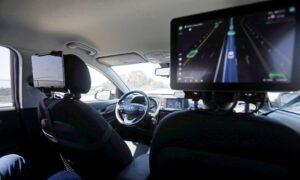B.C. legislation prohibiting the use of fully automated self-driving vehicles is now in effect as part of the province’s push to keep its roads safer.
Changes to the province’s Motor Vehicle Act came into effect without fanfare earlier this month to ban the use of automated features such as driverless steering, accelerating, and braking on B.C. roads.
“These new regulations will keep people safer on our roads and encourage even more use of active transportation,” Transportation Minister Rob Fleming said in a statement. “It’s another step in modernizing our rules to keep up with new technologies that are changing how people are getting around.”
The new legislation makes it illegal to drive Level 3 or higher automated vehicles. The province describes levels 3 to 5 vehicles as having “highly automated self-driving capabilities” that do not require a person to be in control of the vehicle when automated features are engaged.
The province has said it has no plans to change its driver automation policies until further testing determines Level 3 or higher automated vehicles are considered safe.
Motorists caught driving a fully automated vehicle in B.C. could be fined up to $2,000 and face as much as six months in jail.
Levels of vehicle automation are determined by the Society of Automotive Engineers (SAE) International. The SAE has five levels of driving automation, ranging from no automation to fully-automated. Level 0 has no driving automation while vehicles with automation Level 1 and 2 have some driver-assisted technology but still require the motorist to be in control of the vehicle.
Level 1 offers driver assistance such as cruise control and Level 2 offers partial driving automation such as lane assist and adaptive cruise control at the same time. Lane assist alerts distracted or sleepy drivers that the vehicle is too close to a lane marker.
Level 3 offers conditional driving automation such as a traffic jam chauffeur feature while Level 4 comes with high driving automation and may or may not have pedals and a steering wheel installed. A Level 5 vehicle offers full driving automation.
Automated Driving by Province
Automated vehicle technology and testing is a joint responsibility between Ottawa and provincial governments. While the provinces are responsible for regulating individual drivers and vehicle operation in their respective jurisdictions, Transport Canada creates safety regulations for vehicles that are sold within, or imported to Canada, according to Canadian law firm Borden Ladner Gervais (BLG).
In both Ontario and Quebec, motorists can drive a Level 3 vehicle that is commercially available in Canada but Level 4 and 5 vehicles can only be driven by authorized applicants for testing purposes. Manitoba also allows some testing, but only with a permit.
Alberta doesn’t currently address autonomous vehicle operation in its legislation, but the province has green-lighted a number of pilot programs involving long-haul trucks, BLG said.
In Saskatchewan, the Traffic Safety Amendment Act established a framework in 2020 for the provincial administrator to issue regulations and permits for autonomous vehicles, according to Wagners law firm.
The Nova Scotia Traffic Safety Act has new provisions for autonomous vehicles, but requires royal proclamation to be in effect, the firm said in a blog post.
New Brunswick, Prince Edward Island, Newfoundland and Labrador, and the three territories have yet to develop a regulatory framework to address testing and deployment of automated vehicles.














 English (US) ·
English (US) ·  Turkish (TR) ·
Turkish (TR) ·